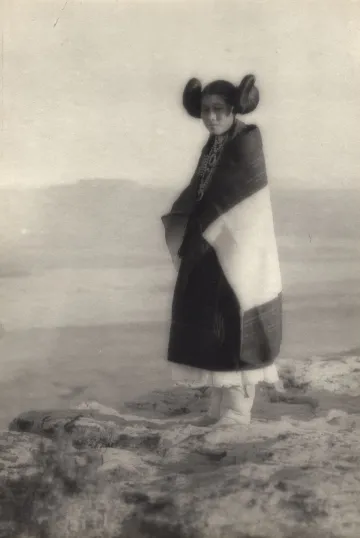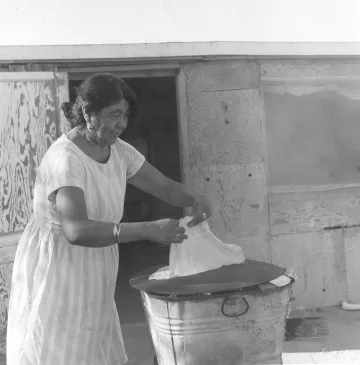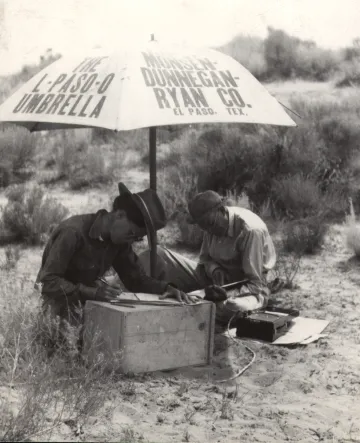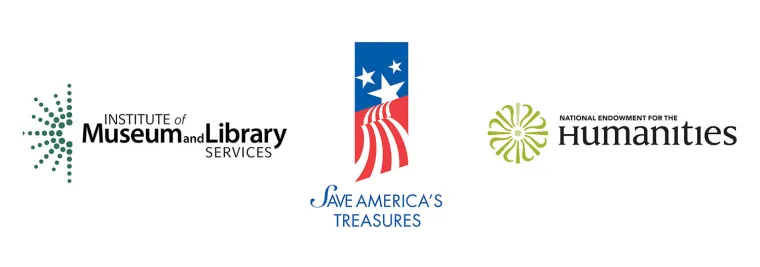
Girl wearing butterfly whorls, Walpi, First Mesa, Hopi Reservation, Arizona. Forman Hanna, photographer, c. 1920
January 2022
Arizona State Museum (ASM) is seeking a final $100,000 in cash donations to complete a campaign for much-needed environmental upgrades to preserve its highly prized photographic collection.
The total project budget is $2.25 million. Federal grants in the amounts of $500,000 and $350,000, in-kind contributions from the University of Arizona (UA), and private donations large and small are combining to bring this important initiative within reach.
The Need
Currently, ASM’s photographic collection is stored in seven separate and cramped rooms that lack climate control and room for growth. These conditions put the collection under immediate and persistent threat of chemical and physical degradation.
The Vision
The vision is a secure and controlled multi-climate (ambient, cold, and frozen) suite on the third floor of ASM’s north building. This will immediately stabilize ASM's sensitive and at-risk media. It is estimated that this facility will extend the life of a color slide, for example, by one thousand years, ensuring that the entire collection will continue to be available to students, researchers, members of Native American communities, and the general public for centuries to come.
American Treasure/National Significance
ASM’s photographic collection attained American Treasure status in late 2018. This designation honors and underscores the significance of one of the nation’s unparalleled collections of anthropological photographic materials—one that documents human ingenuity and cultural traditions in what is now the U.S. Southwest and northern Mexico, from 13,000 years ago (represented through
archaeology) to the present.

Maria Murrieta making tortillas, Pascua Village, Tucson, Arizona. Helga Teiwes, photographer, 1976.
Breadth and Depth
ASM’s collection includes more than 525,000 photographic prints, negatives, and transparencies, and more than 250 motion picture films. No other visual archive has the same depth and breadth in its coverage of the human history of our region. Individual images range from historic to modern, from documentary to fine art.
The collection as a whole illustrates milestones in the development of the disciplines of American archaeology and anthropology. Early archaeological images document both artifacts and fieldwork. Seminal excavations chronicled include those at Ventana Cave, Naco, Lehner Ranch, Point of Pines, and Grasshopper Pueblo.
Early ethnographic images reflect the colonial encounter and the acute national interest in the peoples and cultures of the region at the time when the U.S. was at the height of its westward exploration and expansion, with painful consequences for Indigenous peoples. ASM’s images of contemporary American Indian peoples capture traditional lifeways as well as contemporary artists and art forms. Key contributors include Grenville Goodwin, Helga Teiwes, and Edward and Rosamund Spicer. Smaller portions of the collection cover such topics as aesthetic photography in Arizona, the mission architecture of Sonora, and Mexican Indian costumes.
Images give the objects in ASM’s other nationally significant collections context. They may serve as evidence of the cultures from which they came, the individuals by whom they were made, the materials and technologies used to produce them, the ways in which they were used, or—in the case of archaeological finds—the circumstances of their discovery. Images of individuals, groups, and communities illuminate identity, diversity, lifeways, and resilience.

Anna Osler Shepard and her father, H. Warren Shepard, at the Harvard Peabody Museum camp at Awat’ovi, Arizona. Harriet S. Cosgrove, photographer, 1938. Anna Shepard pioneered ceramic petrography in the United States.
Who Uses the Collection?
Scholars from around the world utilize ASM’s collection for research and to illustrate presentations and publications, including general-interest books, articles, and documentary films. Thousands of visitors enjoy images from the collection in exhibits at ASM and at other museums. The collection's contribution to the greater body of knowledge is far reaching, and its cultural impact is enormous. This irreplaceable resource helped form the foundation of our understanding of the region’s past and it continues to broaden national and international understanding and appreciation of the indigenous cultures of the U.S. Southwest and northern Mexico.
Digitization Is Not Preservation
While digital versions of analog photographs and films increase access, they do not preserve the originals. Original negatives and transparencies often contain information a scan will not capture. Digital media come with their own versions of deterioration, corruption, and loss, and are even costlier in terms of storage and back-up regimens, not to mention the expenses related to keeping up with rapid evolutions in technology in order to ensure that all digital media will be accessible in the future.
ASM’s Incomparable Collections
It is ASM’s highest responsibility to ensure that its vast and important collections and associated records are preserved in perpetuity, so that they will continue to facilitate research and inspire creativity.
ASM cares for more than three million cataloged objects, including 38,000 cubic feet of bulk archaeological research materials. Among these, three specific collections have been federally recognized and designated American Treasures. ASM is the only institution in the country to be so honored, a fact that emphasizes how important ASM’s collections are to our nation’s shared cultural history. ASM’s collection of Southwest Indian pottery, some 24,000 whole vessels dating back 2,000 years, attained American Treasure status in the year 2000. The basketry and fiber arts collection, 35,000 examples dating back 8,000 years, followed suit in 2011. ASM’s collections grow continuously, by about 1,000 cubic feet per year.
Help us finish this project by making a tax-deductible contribution of any size.
Checks payable to "UA Foundation/ASM" with "photography project" in the memo line and mailed to:
Darlene F. Lizarraga
Arizona State Museum
PO Box 210026
Tucson, AZ 85721-0026
If you prefer to give by credit card, call (520) 626-8381.
THANK YOU!






